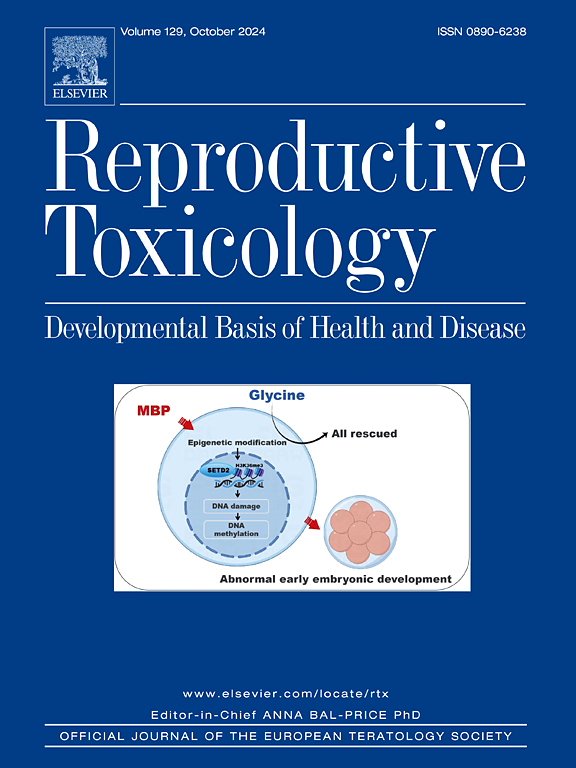Teratogenic effect evaluation of Monascus red oral exposure to pregnant rats and their gut microbiota
IF 3.3
4区 医学
Q2 REPRODUCTIVE BIOLOGY
引用次数: 0
Abstract
Monascus red (MR) is widely used as a natural food colorant and preservative in East Asia. However, the potential effects of MR during pregnancy remains unknown. In this study, MR was administrated to Sprague-Dawley (SD) rats at doses of 0, 0.50, 1.58, and 5.00 g/kg bw on gestational days 6–15 by oral gavage. In the maternal and embryo-fetal examinations, there were no marked toxicities in terms of general clinical signs, body weight, food consumption, serum endocrine indices, organ weights, thyroid histopathology, examinations of uterine contents and fetuses. In the gut microbiota analysis, the 5.00 g/kg bw dose of MR decreased the α diversity and slightly changed their community structure at the genus level. Yet no marked toxicities in maternal animals or embryo-fetal development were observed. The no-observed-adverse-effect-level (NOAEL) of the maternal and developmental toxicity through oral exposure to MR was 5.00 g/kg bw, the highest dose tested in rats.
妊娠大鼠口服红曲霉及其肠道菌群的致畸作用评价。
红曲红在东亚地区被广泛用作天然食品色素和防腐剂。然而,MR在怀孕期间的潜在影响尚不清楚。在本研究中,SD大鼠在妊娠6-15天以0、0.50、1.58和5.00g/kg bw的剂量灌胃给予MR。母胎胎检查中,一般临床症状、体重、食量、血清内分泌指标、脏器重量、甲状腺组织病理学、子宫内容物及胎儿检查均未见明显毒性反应。在肠道菌群分析中,5.00g/kg bw剂量的MR降低了α多样性,并在属水平上轻微改变了它们的群落结构。然而,在母动物或胚胎发育中没有观察到明显的毒性。口服MR对母体和发育毒性的未观察到不良反应水平(NOAEL)为5.00g/kg bw,是在大鼠中测试的最高剂量。
本文章由计算机程序翻译,如有差异,请以英文原文为准。
求助全文
约1分钟内获得全文
求助全文
来源期刊

Reproductive toxicology
生物-毒理学
CiteScore
6.50
自引率
3.00%
发文量
131
审稿时长
45 days
期刊介绍:
Drawing from a large number of disciplines, Reproductive Toxicology publishes timely, original research on the influence of chemical and physical agents on reproduction. Written by and for obstetricians, pediatricians, embryologists, teratologists, geneticists, toxicologists, andrologists, and others interested in detecting potential reproductive hazards, the journal is a forum for communication among researchers and practitioners. Articles focus on the application of in vitro, animal and clinical research to the practice of clinical medicine.
All aspects of reproduction are within the scope of Reproductive Toxicology, including the formation and maturation of male and female gametes, sexual function, the events surrounding the fusion of gametes and the development of the fertilized ovum, nourishment and transport of the conceptus within the genital tract, implantation, embryogenesis, intrauterine growth, placentation and placental function, parturition, lactation and neonatal survival. Adverse reproductive effects in males will be considered as significant as adverse effects occurring in females. To provide a balanced presentation of approaches, equal emphasis will be given to clinical and animal or in vitro work. Typical end points that will be studied by contributors include infertility, sexual dysfunction, spontaneous abortion, malformations, abnormal histogenesis, stillbirth, intrauterine growth retardation, prematurity, behavioral abnormalities, and perinatal mortality.
 求助内容:
求助内容: 应助结果提醒方式:
应助结果提醒方式:


